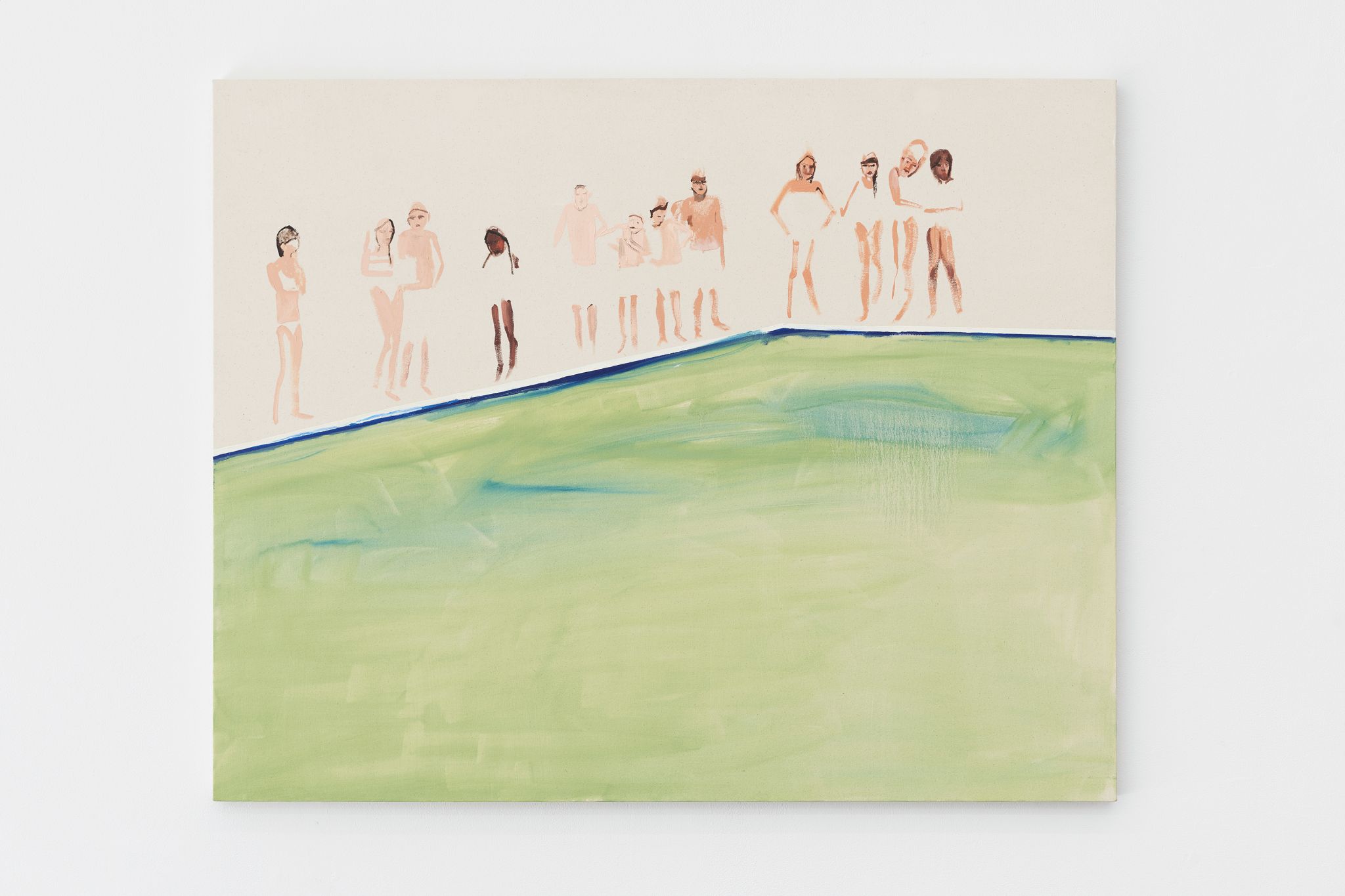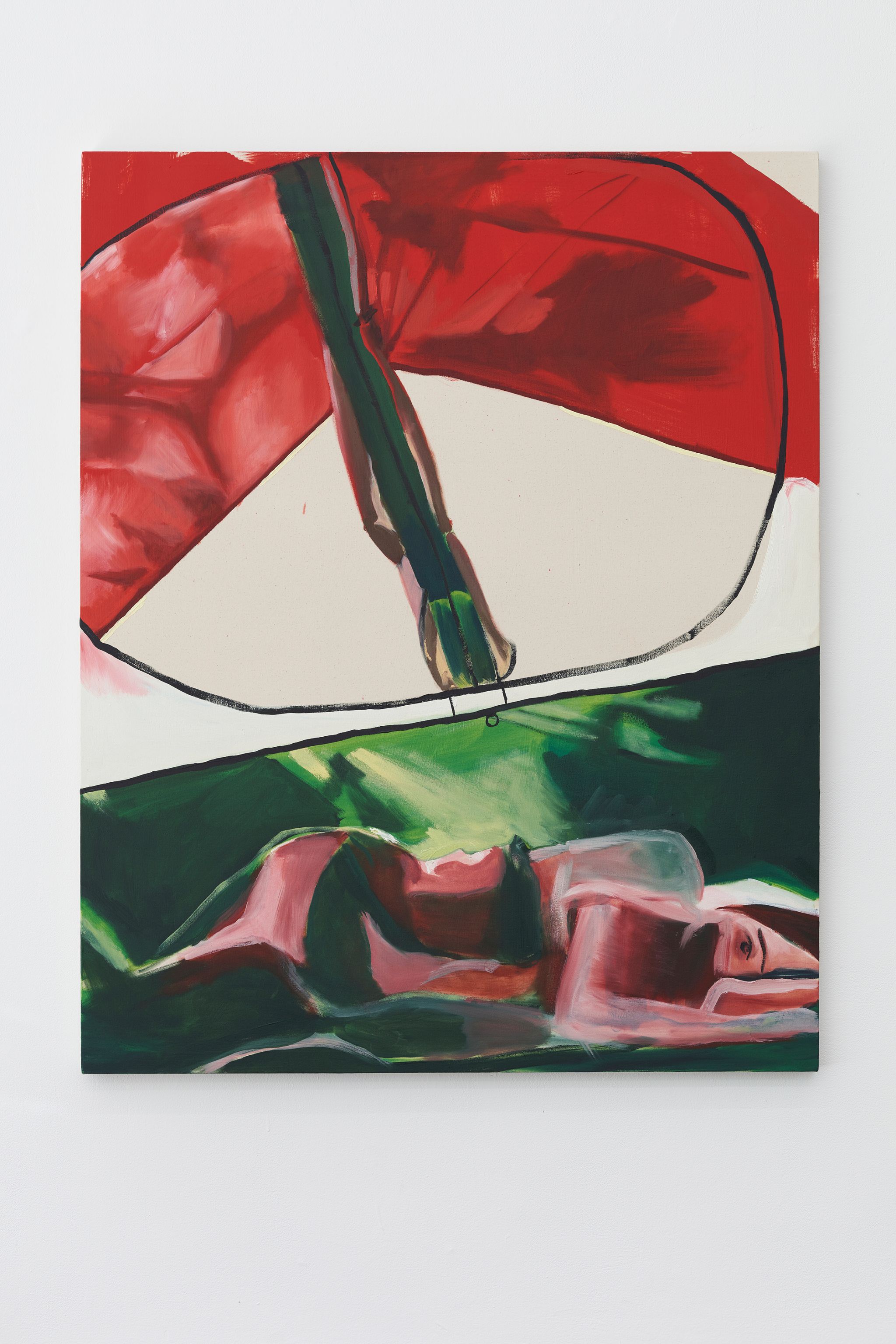“One of my anthropology professors said that we might think of ourselves as an archipelago, and technology as the water surrounding us. His point was that we are becoming increasingly disparate islands as the water rises. Yet, this distancing might be something that also connects us the way a funeral might bring family together: we are only as healthy as the most vulnerable among us.”
– Brenda Draney during the preperations for her exhibition Break
read more
In Brenda Draney’s paintings, a worldview dominates that appears intimate but at the same time is distant from the artist herself. In particular, Draney’s artistic practice derives from her personal and institutional experiences as an indigenous woman living in Canada. Draney is Cree of the Sawridge First Nation, Treaty 8, with a strong connection to the area around Slave Lake, a small town a few hundred kilometers northwest of Edmonton, the capital of the Canadian province of Alberta. Slave Lake is at the center of this vast rural area; all administration of the Sawridge First Nation reservation happens from here. Draney was born in 1976, and like many of her generation, moved to Edmonton to study English after graduating from high school. Later she studied at the Emily Carr University of Art and Design in Vancouver, the school where many well-known Canadian conceptual artists studied.
The pictures Draney has created since then address real-life events as everyday, individual fates, but staged in a decidedly hermetic way. The search for an identification with one’s own origins, as well as the observation and analysis of the dramatic social changes of our present moment, characterize the artist’s visual worlds. Draney repeatedly addresses private moments and biographical circumstances. Her imagery offers just enough information to enable access to the subject. On the one hand, the viewer can develop their own narratives based on what is shown; on the other hand, emphatically narrative pictorial gaps remain. These conscious gaps and free spaces create a tension between faith in the image’s capacity to thematize one’s own biography, however fragile, and a generalization that positions reality in thrall to a pronounced subjectivism.
At the center of her painterly compositions, Draney places personal stories and episodes along with things from her surroundings. Strong brushstrokes meet an intuitive, gestural color scheme, which creates the impression of agreement between real experience and the abstract image. These paintings are not just self-reflection, but an act of self-assertion. Draney continually breaks up her painterly continuum. In this way, she sketches a painterly approach to the complexity of her world without revealing the terms of her appropriation of it. Rather, it seems as if the pictures revolve around a reality that is ultimately unrepresentable in the mode of figurative painting. In Draney’s work, everyday reality, which is inescapable yet actually incomprehensible, is almost inevitably absorbed in a personal, for us only seemingly tangible, realism.
Text: Nicolaus Schafhausen
„One of my anthropology professors said that we might think of ourselves as an archipelago, and technology as the water surrounding us. His point was that we are becoming increasingly disparate islands as the water rises. Yet, this distancing might be something that also connects us the way a funeral might bring family together: we are only as healthy as the most vulnerable among us.“
– Brenda Draney während der Vorbereitung ihrer Ausstellung Break
read more
In Brenda Draneys Malerei dominiert eine Weltsicht, die intim erscheint, sich gleichzeitig jedoch distanziert zu ihrer eigenen Person verhält. Ihre künstlerische Praxis basiert insbesondere auf ihren persönlichen und institutionellen Erfahrungen als Angehörige der kanadischen First Nations. Sie selbst ist Cree der Sawridge First Nation, Treaty 8, mit einer starken Verbindung zur Umgebung von Slave Lake, einer Kleinstadt einige hundert Kilometer nordwestlich von Edmonton, der Hauptstadt der kanadischen Provinz Alberta. Slave Lake ist das Zentrum dieser weiten ländlichen Region; von hier aus wird das Reservat der Sawridge First Nation verwaltet. Wie viele ihrer Generation zog es Draney, die 1976 geboren wurde, im Anschluss an ihren Schulabschluss nach Edmonton, um dort zunächst Englisch zu studieren. Später studierte sie wie zahlreiche der oft konzeptuell ausgerichteten kanadischen Künstler_innen an der Emily Carr University of Art and Design in Vancouver.
Die Suche nach einer Identifikation mit der eigenen Herkunft sowie die Beobachtung und Analyse der dramatischen gesellschaftlichen Veränderungen unserer Gegenwart charakterisieren Draneys seitdem entstandene Bilder. Ihre Arbeiten thematisieren real existierende Begebenheiten als alltägliche, individuelle Schicksale, inszenieren diese aber in dezidiert hermetischen Bildwelten. Immer wieder adressiert Draney private Momente und biografische Gegebenheiten. Ihre Bildsprache bietet dabei gerade genug Information, um einen Zugang zum Sujet möglich zu machen. Einerseits können die Betrachter_innen dadurch eigenen Narrative ausgehend von dem Gezeigten entwickeln, andererseits bleiben emphatisch erzählende, bildliche Leerstellen bestehen. Diese bewussten Lücken und Freiräume erzeugen eine Spannung zwischen einer Selbstvergewisserung qua Bild, um die eigene, als brüchig empfundene Biografie zu thematisieren, und einer Verallgemeinerung, die den ausgeprägten Subjektivismus in eine Verantwortung gegenüber der Wirklichkeit stellt.
Es sind persönliche Geschichten, Episoden und Dingwelten aus ihrer Umgebung, die Draney in das Zentrum ihrer malerischen Kompositionen stellt. Kräftige Pinselstriche treffen auf eine intuitive, gestische Farbführung, was den Eindruck einer Deckungsgleichheit von real Erlebtem und abstrahiertem Abbild erzeugt. Diese Malerei ist nicht nur Selbstreflexion, sondern Akt der Selbstbehauptung. Fortlaufend bricht Draney ihr malerisches Kontinuum auf. Auf diese Weise skizziert sie einen malerischen Zugang zu ihrer komplexen Lebenswelt, ohne diese aneignenden Interpretationen preiszugeben. Es scheint vielmehr, als würden die Bilder um eine im Modus figurativer Malerei letztlich nicht repräsentierbare Wirklichkeit kreisen. Die eigentlich nicht fassbare und doch im Zentrum stehende Alltagsrealität geht so fast zwangsläufig in einem persönlichen, für uns nur scheinbar greifbaren Realismus auf.
Text: Nicolaus Schafhausen














